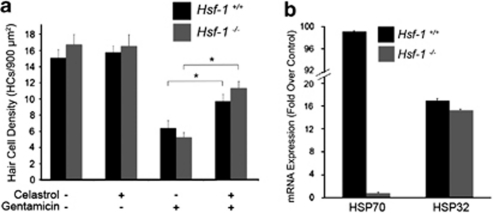Figure 2.
Hsf-1 is not required for celastrol-mediated protection or HSP32/HO-1 induction. (a) Utricles from Hsf-1+/+ and Hsf-1−/− mice were treated with celastrol (1.5 μM for 3 h) and/or gentamicin (5 mM for 24 h). Celastrol did not result in loss of hair cells in utricles from either Hsf-1+/+ or Hsf-1−/− mice. Gentamicin resulted significant hair cell loss in utricles of both genotypes. Celastrol inhibited gentamicin-induced hair cell death in both Hsf-1+/+ and Hsf-1−/− utricles (3-way ANOVA F1,59=34.24, P<0.001). (b) Celastrol induces HSP32/HO-1 expression in the absence of Hsf-1. Utricles from Hsf-1−/− mice and their wild-type littermates were incubated in celastrol for 3 h before RNA extraction. Celastrol resulted in ∼100-fold increase in HSP70 mRNA expression in utricles from Hsf-1+/+ mice, but it did not result in increased HSP70 mRNA in utricles from Hsf-1−/− mice. In contrast, celastrol treatment resulted in similar increases in HSP32/HO-1 mRNA levels in utricles of both Hsf-1+/+ and Hsf-1−/− mice. Error bars represent S.E.M. on real-time qRT-PCRs performed in triplicate

